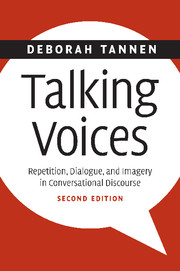Book contents
- Frontmatter
- Contents
- Acknowledgments
- 1 Introduction to first edition
- Introduction to second edition
- 2 Involvement in discourse
- 3 Repetition in conversation: toward a poetics of talk
- 4 “Oh talking voice that is so sweet”: constructing dialogue in conversation
- 5 Imagining worlds: imagery and detail in conversation and other genres
- 6 Involvement strategies in consort: literary nonfiction and political oratory
- 7 Afterword: toward a humanistic linguistics
- Appendix I: Sources of examples
- Appendix II: Transcription conventions
- Notes
- List of references
- Author index
- Subject index
Introduction to second edition
Published online by Cambridge University Press: 23 December 2009
- Frontmatter
- Contents
- Acknowledgments
- 1 Introduction to first edition
- Introduction to second edition
- 2 Involvement in discourse
- 3 Repetition in conversation: toward a poetics of talk
- 4 “Oh talking voice that is so sweet”: constructing dialogue in conversation
- 5 Imagining worlds: imagery and detail in conversation and other genres
- 6 Involvement strategies in consort: literary nonfiction and political oratory
- 7 Afterword: toward a humanistic linguistics
- Appendix I: Sources of examples
- Appendix II: Transcription conventions
- Notes
- List of references
- Author index
- Subject index
Summary
In introducing this new edition of Talking voices I have seen my task as threefold: first, to recontextualize the book in light of current theory; second, to survey related research that has been carried out since the book's original publication; and third, to indicate how my own research has built on and expanded the approach that I introduced and developed here. Addressing these tasks in that order, I begin with a discussion of the theoretical paradigm that this book would now be seen as part of: intertextuality. I discuss how the term has been used, as well as some of the research that has been done under its rubric. Second, I briefly survey research that has been done on repetition and dialogue or, as it is still frequently referred to, reported speech. (I have not come across work done on the topic of details.) Finally, I indicate how my own research has extended and further developed the approach to discourse introduced in this book; first, in a study building most directly upon it – comparison of an author's conversational and fictional accounts of the same incidents – and then in a series of papers analyzing family discourse.
Intertextuality
In recent years, a rich and varied body of research has been carried out under the rubric “intertextuality.” This term, as G. Allen (2000:5) notes in a book that takes the term as its title, “foregrounds notions of relationality, interconnectedness and interdependence in modern cultural life.”
- Type
- Chapter
- Information
- Talking VoicesRepetition, Dialogue, and Imagery in Conversational Discourse, pp. 8 - 24Publisher: Cambridge University PressPrint publication year: 2007

